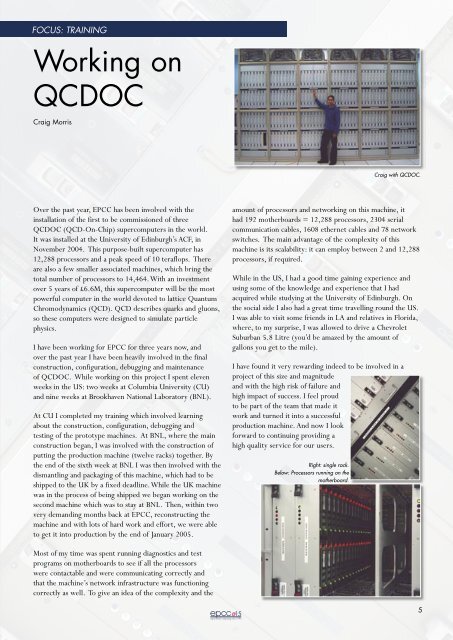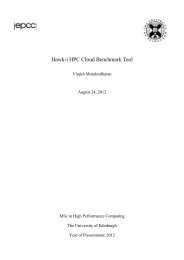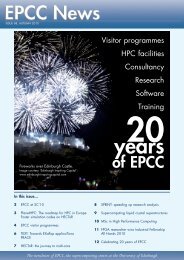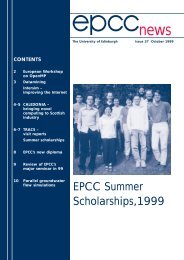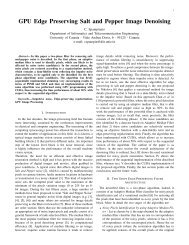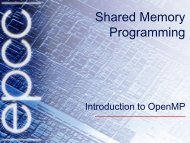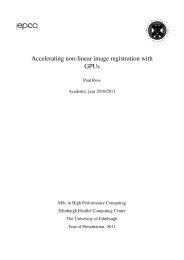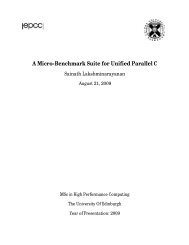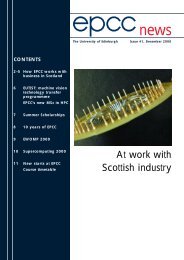Download PDF - EPCC - University of Edinburgh
Download PDF - EPCC - University of Edinburgh
Download PDF - EPCC - University of Edinburgh
You also want an ePaper? Increase the reach of your titles
YUMPU automatically turns print PDFs into web optimized ePapers that Google loves.
FOCUS: TRAINING HARDWAREWorking onQCDOCCraig MorrisCraig with QCDOC.Over the past year, <strong>EPCC</strong> has been involved with theinstallation <strong>of</strong> the first to be commissioned <strong>of</strong> threeQCDOC (QCD-On-Chip) supercomputers in the world.It was installed at the <strong>University</strong> <strong>of</strong> <strong>Edinburgh</strong>’s ACF, inNovember 2004. This purpose-built supercomputer has12,288 processors and a peak speed <strong>of</strong> 10 teraflops. Thereare also a few smaller associated machines, which bring thetotal number <strong>of</strong> processors to 14,464. With an investmentover 5 years <strong>of</strong> £6.6M, this supercomputer will be the mostpowerful computer in the world devoted to lattice QuantumChromodynamics (QCD). QCD describes quarks and gluons,so these computers were designed to simulate particlephysics.I have been working for <strong>EPCC</strong> for three years now, andover the past year I have been heavily involved in the finalconstruction, configuration, debugging and maintenance<strong>of</strong> QCDOC. While working on this project I spent elevenweeks in the US: two weeks at Columbia <strong>University</strong> (CU)and nine weeks at Brookhaven National Laboratory (BNL).At CU I completed my training which involved learningabout the construction, configuration, debugging andtesting <strong>of</strong> the prototype machines. At BNL, where the mainconstruction began, I was involved with the construction <strong>of</strong>putting the production machine (twelve racks) together. Bythe end <strong>of</strong> the sixth week at BNL I was then involved with thedismantling and packaging <strong>of</strong> this machine, which had to beshipped to the UK by a fixed deadline. While the UK machinewas in the process <strong>of</strong> being shipped we began working on thesecond machine which was to stay at BNL. Then, within twovery demanding months back at <strong>EPCC</strong>, reconstructing themachine and with lots <strong>of</strong> hard work and effort, we were ableto get it into production by the end <strong>of</strong> January 2005.amount <strong>of</strong> processors and networking on this machine, ithad 192 motherboards = 12,288 processors, 2304 serialcommunication cables, 1608 ethernet cables and 78 networkswitches. The main advantage <strong>of</strong> the complexity <strong>of</strong> thismachine is its scalability: it can employ between 2 and 12,288processors, if required.While in the US, I had a good time gaining experience andusing some <strong>of</strong> the knowledge and experience that I hadacquired while studying at the <strong>University</strong> <strong>of</strong> <strong>Edinburgh</strong>. Onthe social side I also had a great time travelling round the US.I was able to visit some friends in LA and relatives in Florida,where, to my surprise, I was allowed to drive a ChevroletSuburban 5.8 Litre (you’d be amazed by the amount <strong>of</strong>gallons you get to the mile).I have found it very rewarding indeed to be involved in aproject <strong>of</strong> this size and magnitudeand with the high risk <strong>of</strong> failure andhigh impact <strong>of</strong> success. I feel proudto be part <strong>of</strong> the team that made itwork and turned it into a successfulproduction machine. And now I lookforward to continuing providing ahigh quality service for our users.Right: single rack.Below: Processors running on themotherboard.Most <strong>of</strong> my time was spent running diagnostics and testprograms on motherboards to see if all the processorswere contactable and were communicating correctly andthat the machine’s network infrastructure was functioningcorrectly as well. To give an idea <strong>of</strong> the complexity and the5


